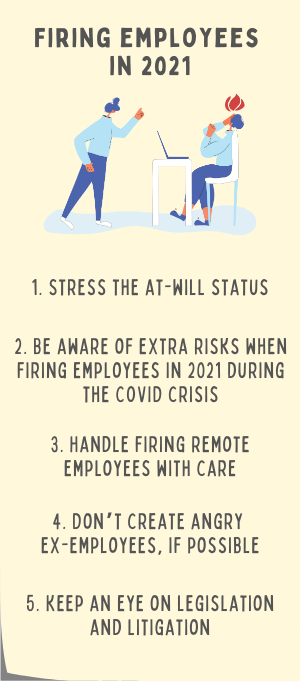Firing employees in 2021: 5 things you need to consider first
 Firing employees in 2021 brings even more challenges than normal. Terminating an employee never ranks among a leader’s favorite tasks. Now throw into the mix additional factors that companies need to keep in mind during the COVID-19 pandemic. The result? An undesirable situation becomes even more difficult.
Firing employees in 2021 brings even more challenges than normal. Terminating an employee never ranks among a leader’s favorite tasks. Now throw into the mix additional factors that companies need to keep in mind during the COVID-19 pandemic. The result? An undesirable situation becomes even more difficult.
Still, terminations are a real part of any business, regardless of the global events taking place. Set the stage for smoother terminations during this unprecedented time with thoughtful consideration of the following five issues.
1. Remain vigilant about stressing at-will status
Unless operating under a contract or a collective bargaining agreement, most modern employment arrangements are “at will.” At-will employment means that an employer can terminate an employee with or without notice for any reason. This, of course, excludes illegal reasons for termination such as sexual or racial discrimination. Likewise, an employee has the right to quit for any reason or no reason.
Make certain workers at your organization understand this concept. In these turbulent times when many companies face tough choices regarding downsizing, restructuring, and cutting costs, employees need to recognize an employer’s right to carry out such decisions. State the at-will arrangement up front and often. This includes in employment applications, employee handbooks, orientation sessions, and staff meetings.
2. Be aware of extra risks when firing employees in 2021 during the continued COVID crisis
Fired workers know the current unemployment rate does not bode well for them quickly finding a new position. The possibility of someone launching a wrongful termination lawsuit always exists. However, in the current environment ex-employees may be more inclined than ever to seek a legal professional to evaluate their case.
Particular areas of concern are age and disability discrimination claims. Companies really need to ensure that dismissal decisions do not disproportionately affect these groups. Employers may convince themselves they are “protecting” workers who might be more vulnerable to COVID by not bringing them back. However, they may be in for a rude awakening. Likewise, discharging workers on the basis that they’ve not adjusted well to telecommuting can look like targeting if most of them happen to be older.
Also, give careful thought before firing someone who has been vocal about safety concerns, protective equipment, or social distancing. Dismissal could appear like retaliation for speaking one’s mind.
3. Handle firing remote employees with care
Much traditional advice still holds true when dismissing someone: Act quickly after the termination decision has been made. If possible, fire at the end of the day and the end of the workweek. Avoid letting someone go via text or email. Make sure the employee knows of his dismissal before the rest of the staff does (as in don’t put out next week’s work schedule that doesn’t include his name before actually having the termination meeting). While these truths remain, firing employees in 2021 also comes with additional considerations with many employees working remotely.
Due to safety concerns, many terminations this year will not take place with the parties physically face to face. A manager needing to terminate someone working remotely should set up a conference call with at least one other company representative on the line to serve as a witness to the conversation. Favor a call over a virtual platform because the latter is too easy for the dismissed employee to videotape and share. Plan ahead how to handle outbursts, and don’t entertain the notion of revisiting the decision. If the employee raises previously unknown discrimination or harassment complaints, announce you’ll investigate the matter but that the termination decision stands until and unless significant wrongdoing is revealed. Deliver any dismissal details or paperwork immediately after the meeting via courier.
Handle mass terminations in a similar manner. Don’t gather physically as this could be viewed as putting employees at risk of COVID exposure and trigger bad publicity. Avoid Zoom or Microsoft Teams in favor of a webcast or similar outlet in which you present the situation and employees observe but do not participate. Set up courier service to deliver termination packets to residences following the broadcast.
4. Don’t create angry ex-employees, if possible
While always a good rule, the current state of the world in 2021 has more people than ever stressed out, and firing employees requires extra care. With jobs hard to find, terminated employees have little to lose and everything to gain by making your life miserable. Visiting an attorney for a free or low-cost consultation may help these ex-employees find routes to getting back at the company that they would not have thought of on their own.
Avoid termination trouble triggers by creating as little drama as possible and treating the person being let go with respect. Quickly provide any payment due or severance. Unless dealing with a case of gross misconduct, try to offer something positive for the person to walk away with. Some examples include a good reference or retraining assistance.
5. Keep an eye on legislation and litigation
Lastly, while seeking legal counsel for termination questions has always been valuable, the team’s participation this year could prove more vital than ever. Changes come quickly and often during the pandemic. Lawyers can keep everyone abreast of issues such as fulfilling WARN and Mini-WARN obligations when discharging a large number of workers. Likewise, a new administration in the White House could bring other changes in employment laws, especially regarding DREAMER certification and other immigration-related topics. Monitoring these decisions will keep your company up-to-date and compliant.
Additional Resource: While 2021 comes with additional considerations when firing employees, don’t forget some of the basic do’s and don’ts of terminations.






